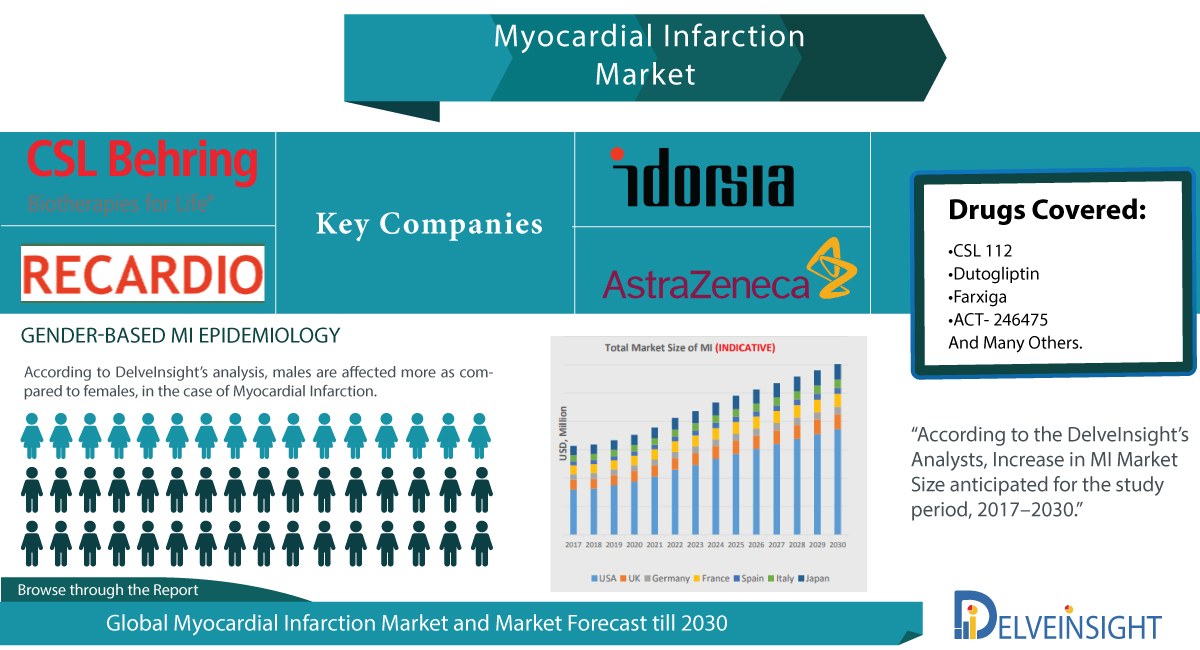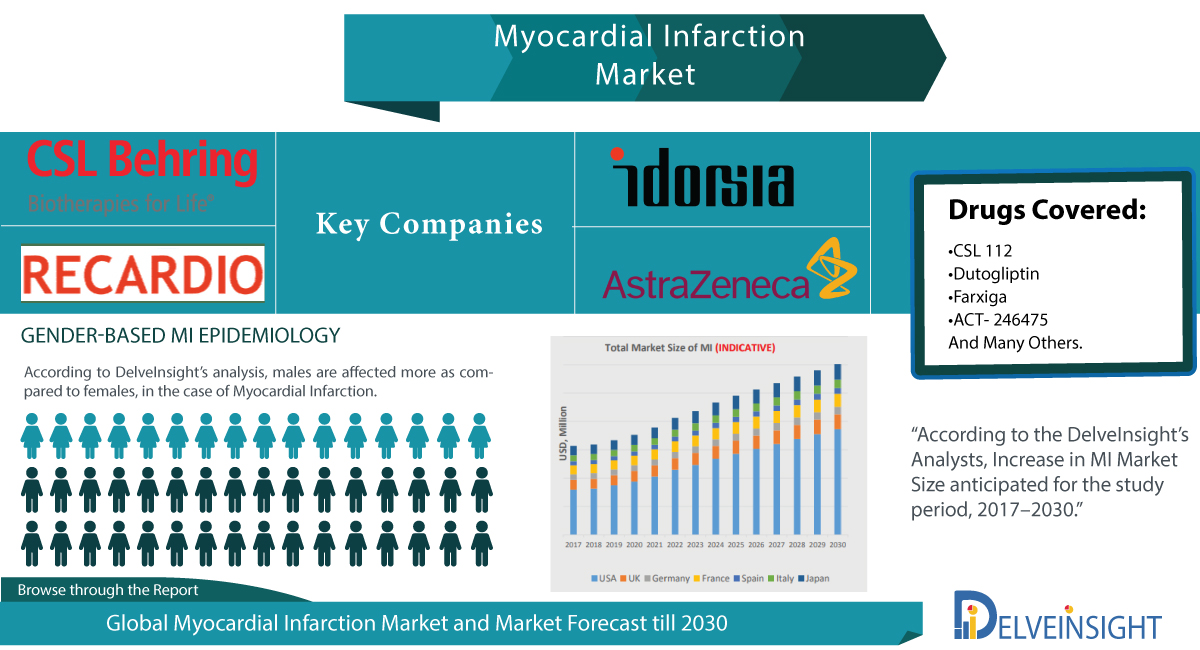Albany, US – DelveInsight has launched a new report on Myocardial Infarction Market Insights, Epidemiology and Market Forecast-2030
DelveInsight’s ” Myocardial Infarction Market Insights, Epidemiology, and Market Forecast-2030 ” report delivers an in-depth understanding of the Myocardial Infarction, historical and forecasted epidemiology as well as the Myocardial Infarction market trends in the United States, EU5 (Germany, Spain, Italy, France, and United Kingdom) and Japan.
Some of the key facts of the Report:
- Myocardial infarction retains a substantial footprint on global health, affecting more than 7 million individuals worldwide each year and
- Myocardial infarction leads to more than 4 million deaths in Europe and northern Asia.
- Every 40 seconds , someone in the United States has a heart attack.
- Drugs in the clinical trials are expected to propel the growth of the MI drugs market in the upcoming years.
- Myocardial Infarction market report covers a descriptive overview and comprehensive insight of the Myocardial Infarction epidemiology and Myocardial Infarction market in the 7 MM (United States, EU5 (Germany, Spain, France, Italy, UK) & Japan.)
- Myocardial Infarction market report provides insights on the current and emerging therapies.
- Myocardial Infarction market report offers a global historical and forecasted market covering drug outreach in 7 MM.
- Myocardial Infarction market report provides an edge that will help in developing business strategies by understanding trends shaping and driving the Myocardial Infarction market.

Request for Sample Pages: https://www.delveinsight.com/sample-request/myocardial-infarction-market
“According to DelveInsight’s analysis, males are affected more as compared to females, in the case of Myocardial Infarction.”
Myocardial Infarction (MI), commonly known as heart attack occurs when blood flow declines or stops to a part of the heart, triggering damage to the heart muscle. The risk of myocardial infarction increases with age. The other causes could be smoking, high blood pressure, diabetes mellitus or high levels of cholesterol. Enormous consumption of polyunsaturated fats can also lead to heart attacks.
Symptoms associated with Myocardial Infarction include chest pain that may appear as a sensation of tightness or pressure initially. Pain radiates most often to the left arm, but may also radiate to the lower jaw, neck, right arm, back, and upper abdomen. Chest pain may be accompanied by sweating, nausea or vomiting, and fainting.
Request for Sample Pages: https://www.delveinsight.com/sample-request/myocardial-infarction-market
Acute Myocardial Infarction is an event of myocardial necrosis caused by an unstable ischemic syndrome. The condition is reported as a common cardiac emergency, prone to substantial morbidity and mortality. The disease occurrence in the absence of critical epicardial coronary disease is increasingly observed.
‘According to the DelveInsight’s Analysts, Increase in MI Market Size anticipated for the study period, 2017-2030.
Some of the key companies working on Myocardial Infarction are:
- CSL Behring
- Recardio
- AstraZeneca
- Idorsia Pharmaceuticals
And Many Others.
The launch of the emerging therapies is expected to significantly impact the Myocardial Infarction treatment scenario in the upcoming years:-
- CSL 112
- Dutogliptin
- Farxiga
- ACT‐ 246475
And Many Others.
Request for Sample Pages: https://www.delveinsight.com/sample-request/myocardial-infarction-market
1. Report Introduction
2. Myocardial Infarction Market Overview at a Glance
2.1. 7MM Market Size of Myocardial Infarction in 2017
2.2. 7MM Market Size of Myocardial Infarction in 2030
3. Disease Background and Overview: Myocardial Infarction
3.1. Introduction
3.2. Causes
3.3. Pathophysiology
3.4. Symptoms
3.5. Risk Factor
3.6. Diagnosis
4. Epidemiology and Patient Population
4.1.1. Assumptions and Rationale
4.1.2. 7MM Incident Cases of Myocardial Infarction
4.1.3. 7MM Sex‐Specific Incidence of Myocardial Infarction
4.1.4. 7MM Age‐Specific Incidence of Myocardial Infarction
4.1.5. Diagnosed and Treatable Cases of Myocardial Infarction
4.2. United States
4.2.1. Assumptions and Rationale
4.2.2. Incident Cases of Myocardial Infarction
4.2.3. Sex‐Specific Incidence of Myocardial Infarction
4.2.4. Age‐Specific Incidence of Myocardial Infarction
4.2.5. Diagnosed and Treatable Cases of Myocardial Infarction
4.3. EU‐5
4.3.1.1. Assumptions and Rationale
4.3.1.2. Incident Cases of Myocardial Infarction
4.3.1.3. Sex‐Specific Incidence of Myocardial Infarction
4.3.1.4. Age‐Specific Incidence of Myocardial Infarction
4.3.1.5. Diagnosed and Treatable Cases of Myocardial Infarction
4.3.2. France
4.3.2.1. Assumptions and Rationale
4.3.2.2. Incident Cases of Myocardial Infarction
4.3.2.3. Sex‐Specific Incidence of Myocardial Infarction
4.3.2.4. Age‐Specific Incidence of Myocardial Infarction
4.3.2.5. Diagnosed and Treatable Cases of Myocardial Infarction
4.3.3. Italy
4.3.3.1. Assumptions and Rationale
4.3.3.2. Incident Cases of Myocardial Infarction
4.3.3.3. Sex‐Specific Incidence of Myocardial Infarction
4.3.3.4. Age‐Specific Incidence of Myocardial Infarction
4.3.3.5. Diagnosed and Treatable Cases of Myocardial Infarction
4.3.4. Spain
4.3.4.1. Assumptions and Rationale
4.3.4.2. Incident Cases of Myocardial Infarction
4.3.4.3. Sex‐Specific Incidence of Myocardial Infarction
4.3.4.4. Age‐Specific Incidence of Myocardial Infarction
4.3.4.5. Diagnosed and Treatable Cases of Myocardial Infarction
4.3.5. United Kingdom
4.3.5.1. Assumptions and Rationale
4.3.5.2. Incident Cases of Myocardial Infarction
4.3.5.3. Sex‐Specific Incidence of Myocardial Infarction
4.3.5.4. Age‐Specific Incidence of Myocardial Infarction
4.3.5.5. Diagnosed and Treatable Cases of Myocardial Infarction
4.4. Japan
4.4.1.1. Assumptions and Rationale
4.4.1.2. Incident Cases of Myocardial Infarction
4.4.1.3. Sex‐Specific Incidence of Myocardial Infarction
4.4.1.4. Age‐Specific Incidence of Myocardial Infarction
4.4.1.5. Diagnosed and Treatable Cases of Myocardial Infarction
5. Treatments Algorithm
5.1. United States
5.2. Europe
5.3. Japan
6. Marketed Products
6.1. Inspra: Pfizer
6.1.1. Mechanism of action
6.1.2. Regulatory Milestones
6.1.3. Advantages and disadvantages
6.1.4. Safety and efficacy
6.1.5. Side effects
6.1.6. Product Profile
6.2. Plavix: Bristol‐Myers Squibb/Sanofi Pharmaceuticals
6.2.1. Mechanism of action
6.2.2. Regulatory Milestones
6.2.3. Advantages and disadvantages
6.2.4. Safety and efficacy
6.2.5. Side effects
6.2.6. Product Profile
To be continued in report…
7. Emerging Therapies
7.1. Key Cross Competition
7.2. Dutogliptin: Recardio
7.2.1. Regulatory Milestones
7.2.2. Clinical Development
7.2.3. Product Profile
7.2.4. Clinical Pipeline Activity
7.2.4.1. Ongoing Trials Information
7.2.4.2. Clinical Trial by Phase
7.3. CSL 112: CSL Behring
7.3.1. Regulatory Milestones
7.3.2. Clinical Development
7.3.3. Product Profile
7.3.4. Clinical Pipeline Activity
7.3.4.1. Ongoing Trials Information
7.3.4.2. Clinical Trial by Phase
7.4. Dapagliflozin: AstraZeneca
7.4.1. Regulatory Milestones
7.4.2. Clinical Development
7.4.3. Product Profile
7.4.4. Clinical Pipeline Activity
7.4.4.1. Ongoing Trials Information
7.4.4.2. Clinical Trial by Phase
To be continued in report…
8. 7MM Myocardial Infarction: Country‐Wise Market Analysis
8.1. United States Market Size
8.1.1. Total Market Size of Myocardial Infarction
8.1.2. Market Size of Myocardial Infarction by Therapies
8.2. Germany Market Size
8.2.1. Total Market Size of Myocardial Infarction
8.2.2. Market Size of Myocardial Infarction by Therapies
8.3. France Market Size
8.3.1. Total Market Size of Myocardial Infarction
8.3.2. Market Size of Myocardial Infarction by Therapies
8.4. United Kingdom Market Size
8.4.1. Total Market Size of Myocardial Infarction
8.4.2. Market Size of Myocardial Infarction by Therapies
8.5. Spain Market Size
8.5.1. Total Market Size of Myocardial Infarction
8.5.2. Market Size of Myocardial Infarction by Therapies
8.6. Italy Market Size
8.6.1. Total Market Size of Myocardial Infarction
8.6.2. Market Size of Myocardial Infarction by Therapies
8.7. Japan Market Size
8.7.1. Total Market Size of Myocardial Infarction
8.7.2. Market Size of Myocardial Infarction by Therapies
9. Market Access and Reimbursement
10. Market Drivers
11. Market Barriers
12. Appendix
13. Report Methodology
14. Sources Used
15. DelveInsight Capabilities
16. Disclaimer
17. About DelveInsight
Related Reports:
Myocardial Infarction – Pipeline Insights, 2020
The Myocardial Infarction report provides an overview of therapeutic pipeline activity and therapeutic assessment of the products by development stage, product type, route of administration, molecule type, and MOA type for Myocardial Infarction across the complete product development cycle, including all clinical and nonclinical stages.
Myocardial Infarction – Epidemiology Forecast to 2030
The Myocardial Infarction epidemiology covered in the report provides historical as well as forecasted Myocardial Infarction epidemiology scenario in the 7MM covering the United States, EU5 countries (Germany, Spain, Italy, France, and the United Kingdom) and Japan from 2017 to 2030.



